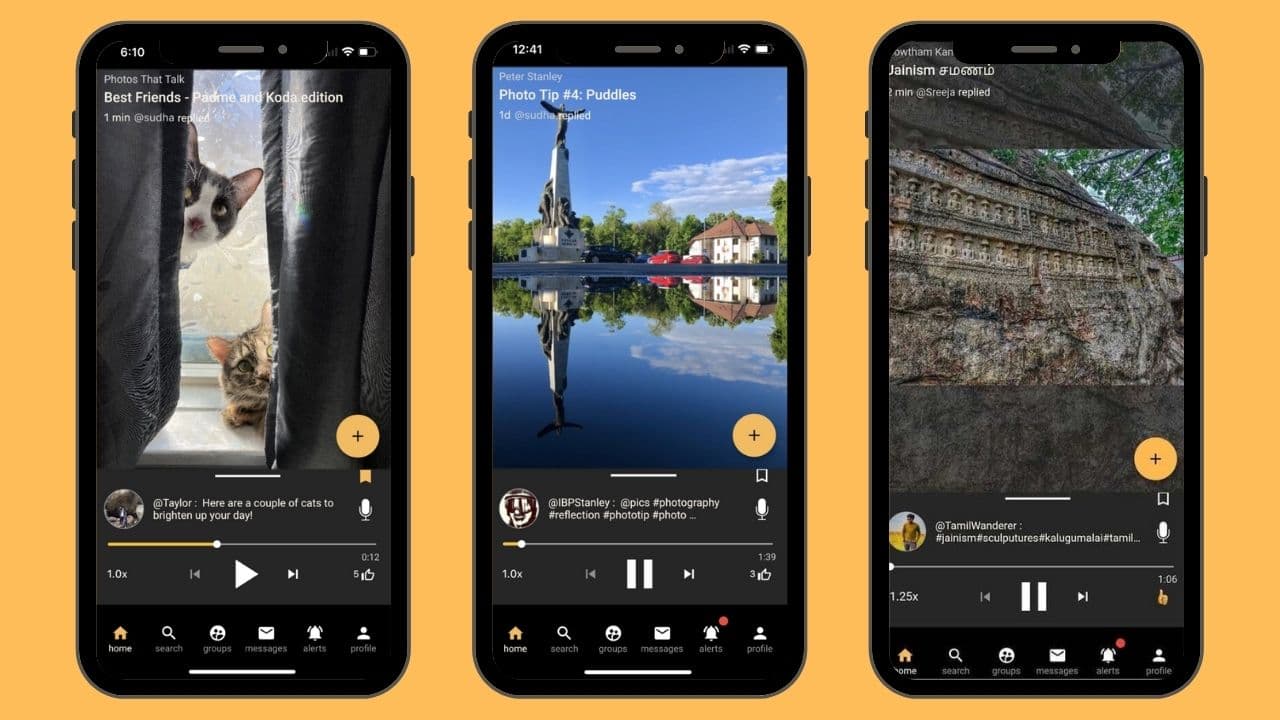Nandini YadavJul 15, 2021 11:19:02 IST
Clubhouse and Twitter Spaces may seem like the last word on the drop-in audio chat format, but the space is evolving faster than you may realise.
A San Francisco startup called Swell, by co-founders Sudha K Varadarajan and Arish Ali, is a new voice-based social platform which – at the first look – seems like a blend of WhatsApp voice notes, Instagram feeds, and Clubhouse audio chat but the final concoction is unique – and its beauty is asynchronicity.
As opposed to a platform like Clubhouse where conversations are now or never – meaning you either hear them live or miss them entirely – Swell allows users to post standalone (up to five minutes long) audio clips with an accompanying image and links that show up on a feed. Other users can browse, listen and leave their own audio responses in their own time.
Swell has options for audio-only group chats, private conversations (think: DMs), or public conversations called Swellcasts. A Swellcast is more like a conversation thread on Twitter, except the conversation here comprises audio clips.
To learn more about how Swell works, how it’s different from platforms like Clubhouse, how challenging content moderation is on audio-based platforms, and why the audio format is the Goldilocks zone of conversation, we spoke to Swell co-founder and CEO Sudha K Varadarajan.
Tech2: What makes the audio-chat format so comfortable to adapt to, and hence so popular?
Varadarajan: Talking is the most natural form of communication – something humans have evolved to become comfortable with over thousands of years. Social platforms driven by text have forced people to communicate in a way that is not natural – using compressed text and emojis. This is why voice based audio chat has been a refreshing change and popular as it has allowed people to revert to a more natural way of communication. On the other extreme, video chats tend to be very intrusive and place a much higher demand on us – we worry about how we look, where we are, bandwidth for video etc. which takes us away from focusing on the conversation and just getting our voice heard.
Audio, as a mode, comes free of such constraints, allowing the users to only focus on their communication, hassle-free, and this is why it has become so popular.
Tech2: How is Swell different from Clubhouse or Twitter Spaces?
Varadarajan: Swell is very different from any other live drop-in audio platform, both in terms of functionality and purpose.
On Swell, users can post audio clips of up to 5 minutes, which can be heard by anyone at their own convenience; these posts can be accompanied by other media like photos and links. Users don’t have to be present in real-time to be a part of the conversations. So, unlike Clubhouse or Twitter Spaces, on Swell, the nature of the conversations is asynchronous.
Alongside, the platform aims at keeping the conversations non-polarized and humanized, carrying a distinct intent, emotion and empathy, unlike most social media platforms. Users talk about topics like a native recipe they tried or a beautiful place they explored in standalone Swellcasts.
The 5-minute cap also ensures that users get access to a diverse range of content in a short duration i.e. an user will be able to listen to 20 different Swells and reply to 10 different people, in the time it takes for him to listen to one entire podcast episode. The fast-paced nature of the platform has been designed to make it relevant and appealing for the younger audience because that is the fastest-growing demographic segment for the audio space right now.
Tech2: How difficult is content moderation for platforms like Swell and Clubhouse?
Varadarajan: The structure and culture of Swell makes moderation a much easier problem for Swell than it has been for other audio platforms like Clubhouse.
The biggest challenge in private real-time audio chat, and also some would argue their biggest attraction, is that it is private and so people feel less inhibited and can say anything they want, resulting in conversations that can need a lot of moderation to avoid offending and hurting individuals and groups.
Swell, on the other hand, from day one has been about authenticity and accountability. Most conversations on Swell are public that anyone can hear at any point of time. Swell is also asynchronous, which means people can think before they respond and say anything. This ensures people are already self-moderating and being thoughtful before they post on Swell. There is less chance for a heat of the moment rant that they may require moderators to jump in.
That said, in general content moderation for any social media network is a hard problem since the content is solely user-generated. So the more the number of users – which is a boon for the platform – the more the requirement for a robust monitoring mechanism.
For Swell, we have decided to give the power back to the users in that they have complete moderation rights. Users are allowed to delete any response to their posts that they find offensive or unpleasant, without being questioned by the Swell moderation team. Similarly, for Swellcasts, all co-hosts have moderator rights.
Additionally, if any user finds any post inappropriate, they can report the same to the Swell moderation team for a prompt review and action as per the app’s terms of service.
Tech2: With Twitter joining this space earlier this year, how challenging is it for platforms like Swell to find their audience?
Varadarajan: We believe that the audience that would visit a live drop-in audio platform would also visit Swell, depending upon their purpose of visit. For example, a user can listen to a topic of interest in a real-time conversation on a drop-in platform. But that would only be a finite session, so once it ends, nothing would stop him from talking about what he liked about the conversation, his key takeaways, on Swell. Because Swell is a platform for people to share their life in audio, not restricted to any specific topic or time.
So, we believe that we will gradually build up our audience base, as Swell complements the other industry players and doesn’t compete with them.
Tech2: Twitter and Clubhouse are both experimenting with a monetisation model, is Swell working on something similar?
Varadarajan: Right now, our focus is on giving users a humanised and authentic social-audio networking experience. And to do that we have ruled out any ad-based monetisation models for now. Going forward, we will look at generating revenues through exclusive premium subscriptions and charge-based access to some of the premium features of the app.
While the first option will allow users to access the content of a creator they really like listening to by paying a certain price, the second alternative is pretty self-explanatory. However, there is still some time for these features to be available.
Tech2: Is audio the future?
Varadarajan: It might not be correct to say audio is the future because that might imply that it wasn’t there in the past or doesn’t exist in the present. Audio was and is very much there, say through FM or radio or other medium. Social-audio is only another new dimension of that industry, which is here to stay. And it will complement all the other forms of communication, be it visual or text-based, owing to individual preference, requirement or functionality.











